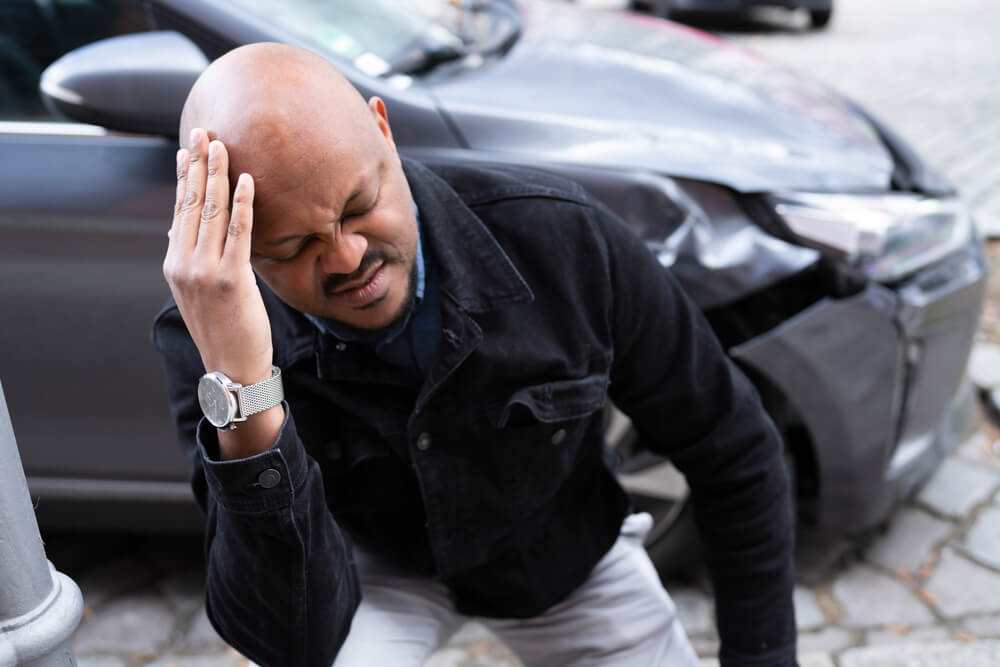victims for over 25 years.
Common Injuries Sustained in Colorado Car Accidents
As a personal injury attorney in Denver, I see the tragic results of car crashes every day and, too often, they start to seem predictable. At the risk of sounding like these incidents are routine, which I know they are NOT when they happen to you or someone you love, I thought it would be prudent to share some of the most common injuries sustained in car accidents, as well as the most common ways to prevent these injuries.
The Most Common Injuries After a Colorado Car Crash

Whiplash
When vehicles collide with sudden force, whiplash often takes center stage. This injury occurs when the neck is rapidly jerked beyond its natural range of motion. Victims of rear-end collisions are particularly prone to this painful condition, which manifests in symptoms like neck pain, headaches, and reduced mobility.
Airbag Injuries
Airbags, designed as life-saving mechanisms, can also cause some of the common injuries sustained in car accidents. The rapid deployment of airbags can lead to wrist fractures, hand injuries, and abrasions if passengers don’t place their hands correctly at the time of impact.
Chest Injuries
In broadside collisions, where vehicles are struck on the driver’s side, chest injuries are a common consequence of car accidents. These injuries are the result of the driver’s chest slamming into the steering wheel or dashboard. Severe cases can result in broken ribs, lung injuries, and damage to vital organs.
Head Injuries
Traumatic brain injuries (TBIs) are a looming danger in high-impact car accidents. When a vehicle comes to a sudden stop, the deceleration can cause the brain to jolt inside the skull, leading to head injuries that range from mild concussions to severe TBIs. These injuries can lead to long-term cognitive impairment and, in some cases, prove fatal.
Spinal Cord Injuries
High-impact car accidents, such as head-on collisions, can result in spinal cord injuries. The spinal cord, a vital part of the nervous system, can sustain damage, causing paralysis or a severe loss of mobility and sensation. Such injuries can lead to life-altering consequences.
Fractured Bones
Fractured bones are a common outcome of high-velocity car accidents, where the body is subjected to extreme forces. These common fractures after car accidents can range from simple breaks that heal with time to complex, compound fractures that demand extensive medical attention.
Burn Injuries
When a car accident leads to a fire or explosion, the result is often severe burn injuries. Victims find themselves facing the excruciating pain of burns that may require extensive treatment, including skin grafts and long-term rehabilitation.
Psychological Trauma
Beyond the physical injuries, psychological trauma is an often-overlooked consequence of car accidents. Anxiety, depression, and PTSD can plague victims, making it difficult for them to lead normal lives as they grapple with the emotional aftermath.
Preventing Car Accident Injuries: What Colorado Drivers and Passengers Can Do

Drivers and passengers have the power to reduce their vulnerability by adopting some essential safety measures. A proactive approach to safety can go a long way in preventing or minimizing the most common injuries after car accidents.
Seat Belts: Always a Must
Wearing seat belts in Colorado is a fundamental step in protecting yourself from the worst effects of an accident. For drivers and passengers alike, fastening your seat belt should be non-negotiable. In the event of a collision, seat belts keep individuals securely in their seats, preventing them from being thrown around or ejected from the vehicle.
Proper Headrest Adjustment
Properly adjusting the headrest is crucial in minimizing the risk of whiplash. The top of the headrest should be level with the top of your head, ensuring that it can support your neck in the event of a collision. This is an easy way to prevent some of the most common injuries after car crashes.
Airbag Awareness
When airbags deploy, they do so at a tremendous speed. To minimize the risk of airbag-related injuries, if you have time to react, passengers and drivers should sit back in their seats, at a safe distance from the airbag, with their hands on the lower part of the steering wheel. This will help prevent wrists from being struck with excessive force.
Defensive Driving Skills
Driving defensively in Denver is another pivotal aspect of preventing accidents altogether. Staying alert, maintaining a safe following distance, and being aware of one’s surroundings can help drivers avoid sudden, high-impact collisions.
Child Safety Seats
For parents, investing in proper child safety seats is a vital precaution. Installing them according to manufacturer instructions and keeping children properly restrained can make a crucial difference in the event of an accident.
Safe Driving Habits
Reducing distractions and obeying traffic laws are essential. Distracted driving, which includes activities like texting, eating, or adjusting the radio while driving, significantly increases the risk of accidents.
Regular Vehicle Maintenance
Ensuring that your vehicle is well-maintained is equally important. Regular check-ups, tire maintenance, and brake inspections can help prevent common injuries after car crashes.
Mental Health Awareness
Emotional well-being is just as crucial as physical safety. Acknowledging the psychological trauma that can follow an accident and seeking professional help when necessary is a key step in recovery.
Educating Passengers
Passengers can also play a role in preventing injuries. Encouraging others in the vehicle to wear their seat belts, avoid distracting the driver, and sitting back with proper posture can create a safer environment for all.
Sadly, we are all vulnerable to these common injuries after car accidents every time we drive, no matter how safely we drive. We simply can’t control everyone else on the road. Hopefully, now that you know some of these common injuries and the steps you can take to prevent them, you’ll make some choices to keep yourself and your passengers protected.
Free Consultation
Search For
Recent Articles
- Bicycle Accident Reported at 15th St and Wewatta St in Denver
- Motorcycle and Pickup Truck Collision on W 6th Ave Leaves No Serious Injuries
- Motorcycle and Bus Collision Reported at Blake and Downing Intersection
- Possible DUI Incident on E 9th Ave in Denver Leaves No Serious Injuries
- Motorcycle and SUV Collide at Denver Intersection in Mar Lee Neighborhood
Categories
- Arvada
- Aurora
- Auto Accident eBook
- Auto Insurance
- Bicycle
- Bicycle/Motorcycle Accidents
- Bodily injury
- Car accidents
- Centennial
- Colorado
- Colorado Legislature
- community
- Denver
- Denver Metro Motor Vehicle Accidents
- distracted driving
- DUI Accidents
- Englewood
- Events
- Flood Insurance
- Fort Collins
- Highlands Ranch
- Hit and Run
- In The News
- insurance companies
- Lakewood
- Littleton
- Marijuana DUI
- Motorcycle Accidents
- Motorcycle Insurance
- Motorcycle Law eBook
- Motorcycles
- Newsletter
- Pedestrian
- Personal Injury Law
- Press Release
- Safe Driving
- Safety
- Scooters
- technology
- Tips
- Uncategorized
- vibrio vulnificus bacteria
- Videos
- Westminster
- Winter Driving
- Wrongful Death
Archive
- July 2025
- June 2025
- May 2025
- April 2025
- March 2025
- February 2025
- January 2025
- December 2024
- November 2024
- October 2024
- September 2024
- August 2024
- July 2024
- May 2024
- April 2024
- March 2024
- February 2024
- January 2024
- December 2023
- November 2023
- October 2023
- September 2023
- August 2023
- July 2023
- June 2023
- May 2023
- April 2023
- March 2023
- February 2023
- January 2023
- November 2022
- September 2022
- April 2022
- March 2022
- February 2022
- January 2022
- December 2021
- November 2021
- October 2021
- September 2021
- August 2021
- July 2021
- June 2021
- May 2021
- April 2021
- January 2021
- December 2020
- November 2020
- October 2020
- September 2020
- August 2020
- July 2020
- June 2020
- May 2020
- April 2020
- March 2020
- February 2020
- January 2020
- December 2019
- November 2019
- October 2019
- September 2019
- August 2019
- July 2019
- June 2019
- May 2019
- March 2019
- February 2019
- January 2019
- December 2018
- November 2018
- October 2018
- September 2018
- August 2018
- July 2018
- June 2018
- May 2018
- April 2018
- March 2018
- February 2018
- January 2018
- December 2017
- November 2017
- October 2017
- September 2017
- August 2017
- July 2017
- June 2017
- May 2017
- April 2017
- March 2017
- February 2017
- January 2017
- December 2016
- November 2016
- October 2016
- September 2016
- August 2016
- July 2016
- June 2016
- May 2016
- April 2016
- March 2016
- February 2016
- January 2016
- December 2015
- November 2015
- October 2015
- September 2015
- August 2015
- July 2015
- June 2015
- May 2015
- April 2015
- February 2015
- November 2014
- October 2014
- September 2014
- July 2014
- June 2014
- May 2014
- April 2014
- March 2014
- February 2014
- January 2014
- October 2012
- September 2012
- August 2012
- July 2012
- February 2012
- March 2011
- October 2010